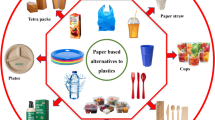Summaries
Monoglycerides (MGs) of four oils (castor, linseed, soybean and sesame) were prepared. They were reacted with a trimer in definite proportions to prepare polyurethane (PU) coatings. These coatings were applied in the form of thin films on tin plates and analysed for various coating properties such as gloss, scratch resistance, flexibility properties and physicochemical tests. A highly cross-linked product was obtained due to the higher functionality associated with MGs compared with their molecular weight. The trimer also imparted cross-linking due to its trifunctionality, and a hard yet flexible, tough, glossy polyurethane coating was obtained.
Résumé
Des monoglycérides (MGs) de quatre huiles (ricin, lin, soya et sésame) ont été préparés. On les a fait réagir, dans des proportions définies, avec une trimère afin de produire des revêtements polyuréthaniques (PU). Ces revêtements ont été appliqués, sous la forme de minces films, à des plaques d’étain, et ont été analysés afin de constater des propriétés de revêtement variées, telles que le brillant, la résistance aux éraflures, les propriétés de flexibilité et [leur performance au cours] des essais physicochimiques. On a obtenu un produit qui était très réticulé grâce à la fonctionnalité plus élevée associée aux MGs par rapport à leur poids molaire. La trimère, aussi, a donné de la réticulation, grâce à sa trifontionnalité, et l’on a obtenu un revêtement polyuréthanique qui était robuste et brillant mais aussi flexible.
Zusammenfassung
Die Monoglyzeride (MGs) von vier Ölen (Rizinus, Leinsamen, Soja und Sesam) wurden hergestellt und mit einem Trimer in bestimmten Proportionen reagiert, um Polyurthanlacke herzustellen. Diese Lacke wurden in dünnen Schichten auf Zinkplatten aufgebracht und nach verschiedenen Eigenschaften wie Glanz, Kratzfestigkeit, Flexibilität und ihren physiochemischen Eigenschaften bewertet. Dank der grösseren Funktionalität im Verhältnis zu ihrem Molekulargewicht erzielten wir mit den MGs ein stark kreuzvernetztes Produkt. Die dreifache Funktionalitat der Trimere trug auch zu der Kreuzvernetzung bei, und der erhaltene Polyurethanlack war sowohl hart als auch flexibel, widerstandsfähig und glänzend.
Similar content being viewed by others
References
Stoye F,Resins for Coatings, 60–80, Hanser Publishers, New York, 1996, ISBN 1-56990-209-7
Ortel G (ed),Polyurethane Handbook, Hanser Publishers, Munich, Vienna, New York, 1993, ISBN 3-446-17198-3
Gite V V, P P Mahulikar, D G Hundiwale and U R Kapadi, ‘Polyurethane coatings using trimer of isophorone diisocyanate’,J Sci and Ind Res, 63, 348–54, 2003
Kordomenos P I and J E Kresta, ‘Thermal stability of isocyanate based polymer. 1: Kinetics of the thermal diissociation of urethane, oxazolidone and isocyanate groups’,Macromolecules,14, 1434–7, 1981
Mistry D E, ‘India: The challenge of self sufficiency’,Oil Technologists Association of India Newsletter, 5, (2), 8–10, 2003
K Holmberg,Coatings Tech Handbook, (2nd edition), 435–45, Marcel Dekker Inc, USA, 2001, ISBN 0-8247-0439-8
Nayak P, D K Mishra, D Parida, K C Sahoo, M Nanda, S Lenka and P L Nayak, ‘Polymers from renewable resources. IX: Interpenetrating network based on castor oil polyurethane poly(hydroxyethyl methacrylate) — synthesis, chemical, and mechanical properties’,J Appl Polym Sci,63, 671–9, 1997
Patel P and B Suthar, ‘Interpenetrating polymer network from castor oil based polyurethane and poly(ethyl methacrylate) XVII’,Polymer,31, 339–43, 1990
Nayak P L, S Lenka, S K Panda and T Pattnaik, ‘Polymers from renewable sources. 1: Castor oil based interpenetrating network — thermal and mechanical properties’,J Appl Polym Sci,47, 1089–96, 1993
Nobori H,J Soc Chem Ind Jpn,46, 646, 1943
Niyogi S, S Sarkar and B Adhikar, ‘Catalytic activity of DBTDL in polyurethane formation’,Ind J Chem Tech,9, 330–3, 2002
Hundiwale D G, PhD thesis, ‘Studies in cast polyester-urethane elastomer’, Indian Institute of Technology, Bombay, India, 1986
Author information
Authors and Affiliations
Corresponding author
Rights and permissions
About this article
Cite this article
Gite, V.V., Kulkarni, R.D., Hundiwale, D.G. et al. Synthesis and characterisation of polyurethane coatings based on trimer of isophorone diisocyanate (IPDI) and monoglycerides of oils. Surface Coatings International Part B: Coatings Transactions 89, 117–122 (2006). https://doi.org/10.1007/BF02699641
Published:
Issue Date:
DOI: https://doi.org/10.1007/BF02699641




